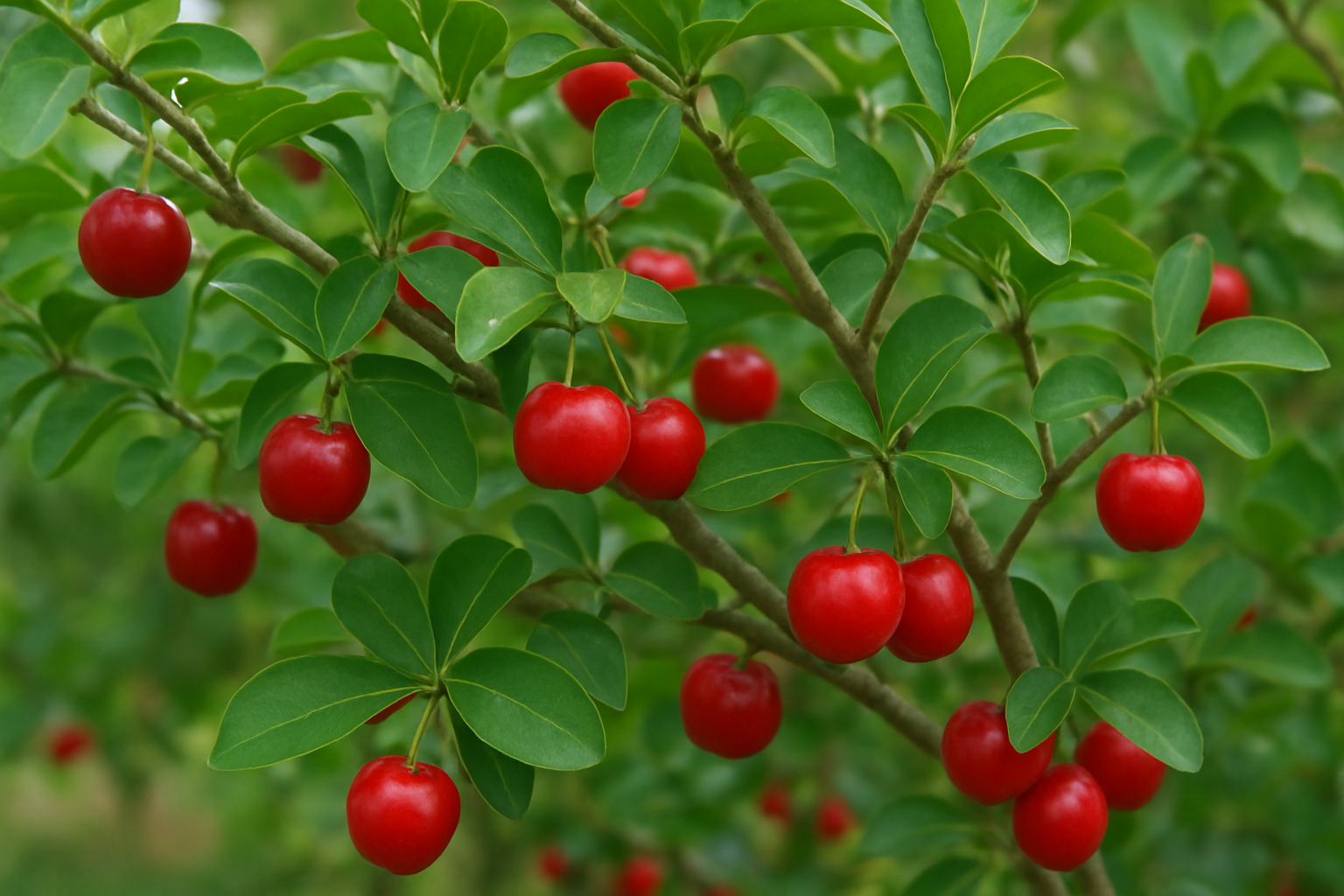The acerola cherry tree is one of nature’s most charming and rewarding fruit trees. Known for its small, bright red fruits bursting with vitamin C, the acerola cherry (also called Barbados cherry or West Indian cherry) has become increasingly popular among home gardeners and health enthusiasts alike.
Native to tropical regions of the Americas, this evergreen shrub or small tree combines both beauty and practicality. Its glossy green leaves and soft pink blossoms make it an attractive ornamental plant, while its nutrient-rich cherries are treasured for their tangy flavor and health benefits.
In this guide, you’ll discover everything about the acerola cherry tree — from understanding its growth habits and ideal conditions to learning how to plant, care for, and harvest it successfully. You’ll also explore how to make the most of its juicy fruit in your kitchen and garden, ensuring you get both aesthetic pleasure and nutritional value from this remarkable tree.
Understanding the Acerola Cherry Tree
The acerola cherry tree (Malpighia emarginata) is a small, spreading evergreen that typically grows between 6 to 15 feet tall. It has a rounded shape, dense foliage, and produces delicate pink-to-white flowers throughout the year in warm climates. Each blossom gives rise to a cluster of cherries, which ripen quickly and vary in shades of red as they mature.
What makes the acerola cherry tree unique is its fast growth and ability to bear fruit at a young age — sometimes within the first two years of planting. It’s not a true cherry like the ones found in temperate regions but shares a similar appearance, with its glossy skin and juicy interior.
In its natural habitat, the acerola cherry tree thrives in tropical and subtropical areas such as Brazil, Puerto Rico, and the Caribbean. It loves warmth, humidity, and full sun, making it ideal for gardeners in similar climates. Unlike temperate cherry trees that need cold winters, acerola cherries flourish in year-round warmth.
While regular cherries come from Prunus species, acerola belongs to a different botanical family. The biggest distinction is in nutrition: acerola cherries are among the richest known sources of vitamin C, often containing 30 to 40 times more than oranges. This makes the acerola cherry tree not just ornamental but also a valuable home-grown superfruit source.
Climate and Soil Requirements
The acerola cherry tree thrives best in warm, humid climates. It prefers temperatures between 70°F and 90°F (21°C–32°C) and can tolerate short dry spells, though consistent moisture helps it produce more fruit. Extended cold or frost can damage the tree, so in cooler regions, it’s best grown in containers that can be moved indoors during winter.
The ideal soil for an acerola cherry tree is well-draining and slightly acidic, with a pH between 5.5 and 6.5. Sandy loam enriched with organic matter gives the best results. Heavy clay soils should be improved with compost or sand to enhance drainage.
Before planting, prepare the ground by loosening the soil and mixing in compost or aged manure. For potted trees, choose a large container with drainage holes and a nutrient-rich potting mix. The tree prefers an open, sunny spot with good air circulation to prevent fungal issues.
How to Grow an Acerola Cherry Tree?
There are two main ways to start growing an acerola cherry tree: from seeds or cuttings. Seeds can be used, but they may take longer to germinate and produce fruit. Propagating from semi-hardwood cuttings is faster and ensures the new tree retains the characteristics of the parent plant.
When planting, dig a hole twice as wide as the root ball but not deeper. Place the tree so the root collar sits level with the soil surface, then backfill and water thoroughly. During the first few weeks, keep the soil evenly moist to help roots establish.
The acerola cherry tree loves full sunlight — at least six hours daily. Too much shade can reduce flowering and fruiting. Water the tree regularly, especially in dry periods, but avoid overwatering. The soil should feel moist, not soggy. Mulching around the base helps retain moisture and keep weeds at bay.
For spacing, leave at least 8 to 10 feet between trees to allow healthy air movement and light penetration. In containers, prune lightly each year to maintain shape and encourage compact, bushy growth.
Caring for Your Acerola Cherry Tree
Once established, the acerola cherry tree is relatively low-maintenance. Regular pruning helps keep its shape, remove dead branches, and promote airflow. It also encourages new growth, which is where most flowers and fruits develop. Light pruning after harvest is ideal.
Mulching with organic material like straw or compost helps the soil stay moist and cool. Feed the tree with a balanced organic fertilizer two to three times a year, especially before flowering seasons. Young trees benefit from nitrogen-rich feed, while mature trees need more phosphorus and potassium for fruiting.
Pests such as aphids, whiteflies, or scale insects may occasionally appear. A mild soap spray or neem oil works well as a natural control. Diseases are rare but can occur if the soil stays waterlogged. Ensuring proper drainage and good airflow helps prevent problems.
In cooler months, protect your acerola cherry tree by covering it with frost cloth or moving container plants indoors. A consistent care routine keeps the tree lush, productive, and visually appealing year after year.
Flowering and Fruit Production
The acerola cherry tree flowers several times a year, particularly after rainfall or irrigation in warm climates. Each flower lasts only a few days but appears in clusters, producing abundant fruit when conditions are right.
Once pollinated — typically by bees and small insects — the small green fruits start to form, turning bright red or orange-red when ripe. The fruiting cycle is fast, with cherries ripening just three to four weeks after flowering.
To ensure healthy fruit development, keep the soil consistently moist during the flowering stage. Mulching helps maintain this balance. Fertilizing with potassium-rich nutrients can improve fruit size and flavor. The tree doesn’t require cross-pollination but can produce more cherries when several trees are planted nearby, encouraging natural pollinator activity.
Harvesting Acerola Cherries
Harvest time for the acerola cherry tree comes quickly and often — a rewarding feature for gardeners. The cherries should be picked as soon as they turn fully red and soft but before they drop. Ripe cherries are delicate and can bruise easily, so handle them gently.
Use your hands or small scissors to snip the fruits individually. It’s best to harvest early in the morning when temperatures are cooler, which helps preserve freshness.
After picking, acerola cherries don’t last long. Their high moisture content makes them perishable, so they should be eaten fresh within a few days. If not consumed right away, refrigerate them or process them into juice, jam, or frozen pulp. This not only preserves their taste but also retains much of their vitamin C content.
Nutritional and Culinary Uses
The acerola cherry is celebrated for its incredible nutritional profile. A single cup of acerola cherries can provide over 1500% of the recommended daily intake of vitamin C. They also contain vitamins A and B, magnesium, and antioxidants that support immunity and skin health.
Fresh acerola cherries have a tangy, slightly tart flavor that blends beautifully in smoothies, juices, and desserts. They can be used in jams, jellies, syrups, and even teas. Some people prefer to mix acerola pulp with other fruits to balance its acidity and enhance the taste.
For long-term use, acerola cherries can be frozen or dried. Freeze them immediately after washing to preserve nutrients. Dried or powdered acerola can be added to health drinks and recipes as a natural vitamin supplement. Beyond nutrition, their bright color and tropical aroma make them a delightful addition to any kitchen.
Common Growing Challenges and Solutions
Even with the best care, the acerola cherry tree may face a few growing challenges. Leaf yellowing is often caused by poor drainage or lack of nutrients. Improving soil quality and adjusting watering routines usually solves the issue.
Fruit drop before ripening may result from irregular watering or sudden temperature changes. Keeping conditions stable and consistent helps the tree retain its fruit.
If you notice pests like aphids or mites, treat the tree promptly with organic insecticidal soap. Avoid using harsh chemicals, as they can harm beneficial insects like bees. For fungal problems such as leaf spots, prune affected branches and apply a natural fungicide if necessary.
Reviving a struggling tree often involves pruning back damaged growth, refreshing the soil with compost, and ensuring it gets enough light and warmth. Once the root system recovers, new growth usually appears within weeks.
Acerola Cherry Tree in Home Gardens and Landscaping
Beyond its health benefits, the acerola cherry tree adds natural beauty to any garden. Its evergreen leaves and soft pink blooms bring color and texture year-round. When covered with red fruit, it becomes a stunning focal point in tropical and subtropical landscapes.
It’s perfect for home gardens, patios, or even balconies when grown in large pots. The tree’s moderate size makes it manageable, and its adaptability allows gardeners to enjoy both visual appeal and productivity.
Planting the acerola cherry tree near patios or walkways enhances your outdoor space while offering easy access to its fruit. In smaller gardens, container-growing is a smart choice. With proper pruning, a potted acerola can remain compact yet highly fruitful — ideal for urban or space-limited gardeners.
Conclusion
The acerola cherry tree is more than just a beautiful addition to your garden — it’s a living source of vitality, nutrition, and joy. From its delicate blossoms to its vibrant cherries, this tropical tree rewards growers with continuous color, delicious fruit, and health benefits unmatched by most other homegrown crops.
By understanding its needs — warm climate, rich soil, and regular care — you can enjoy a thriving tree that produces fruit multiple times a year. Whether you’re cultivating it for its ornamental charm or its vitamin-packed cherries, the acerola cherry tree proves that good things come in small, bright red packages.
Growing one at home is both satisfying and sustainable. With patience and care, you’ll find that the acerola cherry tree not only enhances your garden’s beauty but also supports a healthier, more flavorful lifestyle — one harvest at a time.
My name is Mustafa, and I have been blogging for over 5 years. I am passionate about sharing complete, accurate, and helpful information with my readers. Along with managing content on The Matcha Read, I also contribute blog posts to premium websites. My goal is to provide valuable insights in a clear and easy-to-understand way, so every reader walks away with useful knowledge.










